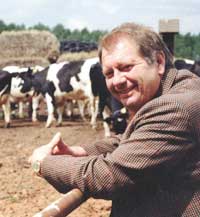Vetwatch: A monthly round-up of vet issues around the UK

Simon Allen, Allen and Partners, Whitland, Carmarthenshire
Monthly milk recording has highlighted economic losses to the dairy industry in improving herd health and milk quality, up to a point. Cows with mastitis or consistently high somatic cell counts are thought of as being on an escalator, with the aim being to take those cows off early with successful treatment and culling any chronic cases remaining.
The advice may include combination treatments during lactation or at drying off which may have to take place earlier than anticipated to achieve a cure without chronic inflammatory changes. Cost calculators are useful decision making tools when used in conjunction with vet advice.
The DairyCo Mastitis Control Plan, which identifies the cause(s) of disease when examining the whole herd, takes it to the next level. It requires a cow-side assessment of teat skin condition which is important because bacterial contamination cannot gain a foothold in healthy skin and establish mastitis.
The report reviews the main points that influence disease and cow comfort and puts the farmer in charge. An action list is implemented and an assessment on the response between the farmer and vet can be made on a regular basis.
 Steve Borsberry, 608 Vet Group, Solihull
Steve Borsberry, 608 Vet Group, Solihull
Cattle are housed now; clipping “backs out” in store cattle improves productivity in two ways – by reducing the incidence of pneumonia and by improving weight gains.
Several suckler groups, when PD’d, have given poor results mainly due to lame bulls and poor body condition of cows post calving, leading to delayed onset of oestrus. While recording is vital, there is little point unless we react promptly to any problems discovered.
In general, farmers who vaccinate against pneumonia continue to vaccinate in the following years – obviously they believe this investment has benefits. There is no doubt reducing the incidence of any disease keeps up staff morale.
There is nothing worse when dealing with a major disease coupled with encouraging staff to commit to changes in practice if positive results take time to show.
This is the time to assess cattle accommodation, some improvements could be made now, others put on the list “to do” in the spring and summer.
 Andrew Schofield, The Minster Vet Practice, York
Andrew Schofield, The Minster Vet Practice, York
What is the true incidence of mineral deficiencies in fattening cattle?
Being based in an area of mixed arable/livestock production, many of our farmers use rations based on home grown cereals. These require the addition of a protein and mineral supplement. On some farms the mineral portion of the diet can be no more than a single “bucket lick”
Recently we have seen a spate of clinical problems related to mineral deficiencies. These have ranged from low vitamin A levels, causing blindness, to problems with low calcium levels causing fractures and recumbancy.
Affected animals are very much the tip of the iceberg. Most problems will be subclinical and affect the immune system causing increased levels of disease such as pneumonia or reduced growth rates and performance. Hence many mineral deficiencies can go unrecognised.
What is without question is if you want to reduce vet med costs the first areas to examine are basic issues such as nutrition and housing, rather than the price of any particular individual drug.
 Neil Laing, Clyde Vet Group, Lanark.
Neil Laing, Clyde Vet Group, Lanark.
Winter is in full swing in Lanarkshire, albeit at the time it normally arrives and not at the end of September as we all feared due to the bad summer.
However, last year’s bad summer has left its mark on the ground as poaching from cattle is evident all over the county. Silage is wetter than it should be and energy levels are not great, which gives nutritionists and farmers another challenge to balance the ration books while trying to keep the financial books balanced too! Second cut silage heating in the clamp, even when the face seems to be well managed doesn’t help, but seems to be common too.
The milk price in this part of the country is not great and particularly First Milk producers seem to be getting the rough end of the stick. Rewards seem to be well below costs of production and I wonder how long this can continue.
All other producers are being squeezed, too, but not to the same extent.
Pneumonia has not been a major issue this winter, which is pleasing because the number of calves being vaccinated in the practice continues to rise every year. This preventative approach benefits farm businesses and calf health, and discussing needs with clients during formal health planning meetings allows both us and the client to focus on problems, and create action plans for dealing with these.
